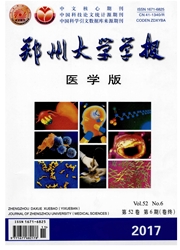

 中文摘要:
中文摘要:
目的:了解血液透析患者动静脉内瘘穿刺疼痛状况及影响因素,为进行有效疼痛管理提供依据。方法:随机整群抽取河南省某市4所三级甲等医院血液净化中心的动静脉内瘘穿刺血液透析患者,采用疼痛视觉模拟法、状态焦虑量表、疼痛自我效能量表、自评抑郁量表及患者一般情况调查表对248例动静脉内瘘穿刺患者进行调查。结果:动静脉内瘘穿刺患者疼痛评分的中位数为4分。穿刺疼痛与焦虑程度得分、抑郁程度得分呈正相关(r s=0.912、0.809,P〈0.001),与疼痛自我效能呈负相关(r s=-0.765,P〈0.001)。穿刺疼痛主要与内瘘使用时间、焦虑和疼痛自我效能有关(β=-0.861、0.372、-0.151,P〈0.05),其OR值(95%CI)分别为0.423(0.194~0.923)、1.450(1.276~1.648)、0.860(0.763~0.970)。结论:对动静脉内瘘血液透析患者的穿刺疼痛管理应予以重视,针对影响因素实施有效干预,以改善患者穿刺疼痛状况。
 英文摘要:
英文摘要:
Aim:To investigate the status and influencing factors of puncture-related pain associated with arteriovenous fistula in hemodialysis patients. Methods:A total of 248 hemodialysis patients with arteriovenous fistula were investigated with the demographic data questionnaire,visual analogue scale,state anxiety inventory,pain self-efficacy questionnaire and self-rating depression scale. Results:The median score of puncture-related pain was 4. The score of pain was positively correlated with the scores of anxiety and depression( r s= 0. 912,0. 809,P 0. 001),and was negatively correlated with the score of pain self-efficacy( r s=- 0. 765,P 0. 001). Regression analysis revealed that using time of arteriovenous fistula,anxiety and pain self-efficacy were the main influencing factors of pain( β =- 0. 861,0. 372,- 0. 151,P 0. 05),and their OR( 95% CI) was 0. 423( 0. 194- 0. 923),1. 450( 1. 276- 1. 648),0. 860( 0. 763- 0. 970). Conclusion:Puncture-related pain management of hemodialysis patients with arteriovenous fistula should be concerned and interventions targeted at the influencing factors of pain should be enhanced.
 同期刊论文项目
同期刊论文项目
 同项目期刊论文
同项目期刊论文
 期刊信息
期刊信息
